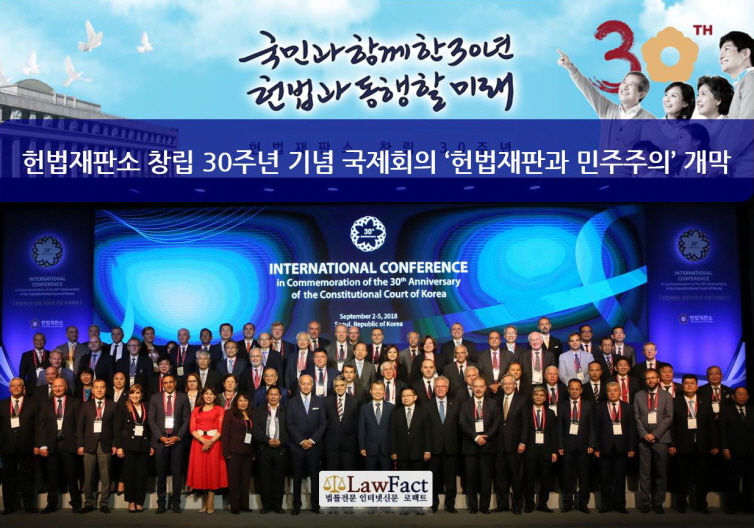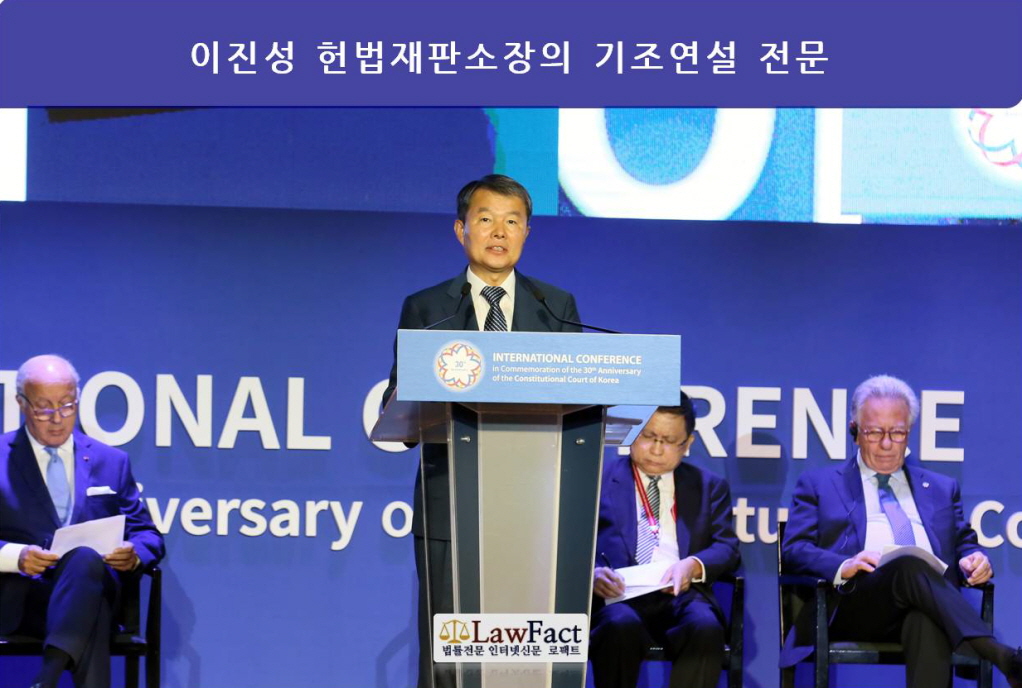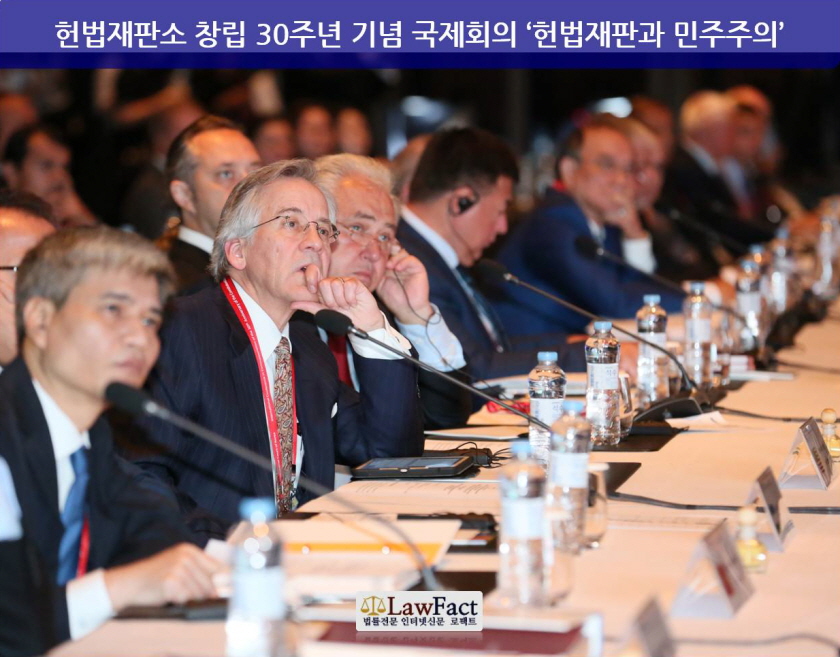[로팩트 김명훈 기자] ‘헌법재판과 민주주의(Constitutional Justice and Democracy)'를 주제로 열리는 헌법재판소 창립 30주년 기념 국제회의가 3일(월) 그랜드 하얏트 호텔에서 개막했다.
이번 국제회의에는 총리·하원의장을 역임한 로랑 파비우스(Laurent FABIUS) 프랑스 헌법위원장, 아시아헌법재판소연합(AACC) 의장국인 말레이시아의 리차드 말란줌(Richard MALANJUM) 연방법원장, 지아니 부퀴키오(Gianni Buquicchio) 베니스위원회 위원장 등 34개국 헌법재판기관의 헌법재판소장, 재판관 및 4개 국제기구 의장 등 세계 각국 헌법재판기관의 주요 인사들이 대거 참석했다.
이진성 헌법재판소장의 개회사와 기조연설로 시작된 이번 국제회의는 제1세션 ‘헌법재판의 역사와 현재’, 제2세션 ‘의회 및 선거와 헌법재판’, 제3세션 ‘인권과 헌법재판’, 제4세션 ‘21세기의 새로운 도전과 대응’ 등 4개 소주제별 발표와 자유토론으로 진행된다.
이진성 재판소장은 1-1세션 의장을 맡고, 안창호 재판관과 유남석 재판관은 각각 3-1세션과 4세션에서 발표하며, 로랑 파비우스(Laurent FABIUS) 프랑스 헌법위원장도 제4세션에서 발표할 예정이다.
헌법재판소는 이번 국제회의 기간 동안 조지아 헌법재판소 및 과테말라 헌법재판소와 상호협력관계 증진을 위한 MOU도 체결할 예정이다.
헌법재판소 관계자는 “이번 국제회의는 민주주의 발전과정에서의 헌법재판소 역할과 각국 사례를 통해 헌법재판소의 존재 의의와 나아가야 할 방향을 심도 있게 논의하고, 대한민국 헌법재판소의 창립 30주년을 세계 각국 헌법재판기관이 함께 축하하는 자리가 될 것으로 기대된다.”고 말했다.
다음은 이진성 헌법재판소장의 창립 30주년 기념 국제회의 기조연설 전문이다.
대한민국 헌법재판소의 창립 30주년을 기념하는 이번 국제회의에서 기조연설을 하게 되어 영광입니다. 대한민국 헌법재판소의 지난날을 돌아보고 새로운 30년의 문을 여는 이 자리에 함께 해 주신 여러분께, 깊은 감사와 환영의 말씀을 드립니다.
대한민국 헌법재판소가 창립되기 한 해 전인 1987년, 민주화를 요구하는 국민의 함성이 전국을 울렸습니다. 이로써 대한민국 국민들은 독재정권을 끝냈고, 헌법을 개정하였습니다. 개정헌법의 옥동자인 헌법재판소는 1988년 9월 1일에 창립되었습니다. 그로부터 지난 30년 동안 헌법재판소는 약 34,000건을 심리하였고, 그 중 1,600건 가량을 위헌으로 결정했습니다.
헌법재판소는 영장 없는 체포를 허용하고, 헌법을 비판하는 사람들을 형사처벌하도록 한 대통령 긴급조치를 위헌으로 선언하였습니다. 호주제, 야간집회금지, 수형자의 선거권 박탈을 규정한 법률도 모두 위헌으로 선언하였습니다. 작년에는 처음으로 전직 대통령의 탄핵심판을 인용하였고, 최근에는 양심적 병역거부자들에 대한 대체복무규정을 두지 않은 병역법 제5조에 대해 헌법불합치 결정을 선고하였습니다.
기본권과 법치주의를 지키기 위한 헌법재판소의 그동안의 부단한 노력 덕분에, 창립 30주년을 축하하고, 이 국제회의를 개최하게 되었다고 생각합니다. 이번 국제회의의 주제는 “헌법적 정의와 민주주의”입니다. 오늘 주제를 보니 화룡점정이라는 고사성어가 생각납니다. 여기에 얽힌 옛날이야기 하나를 들려 드리겠습니다.
옛날 중국에, 용 그림을 잘 그리는 화가가 살고 있었습니다. 어느 날 그 화가가 용이 그려진 벽화를 완성했습니다. 그런데 그 용에는 눈동자가 그려져 있지 않아 다들 의아하게 여겼습니다. “왜 눈동자를 안 그렸지요?” 화가가 대답하기를, “만약 눈동자를 그리면, 용이 하늘로 날아가기 때문입니다” 사람들은 그 말을 믿지 않고 화가에게 눈을 그리라고 졸랐습니다. 화가는 한 숨을 쉬고 눈동자를 그려 넣었습니다. 그 때 갑자기 하늘이 어두워지고 바람이 세차게 불고 천둥 번개가 쳤습니다. 사람들은 용이 그림으로부터 나와 하늘로 올라가는 것을 보았습니다.
세계인권선언과 각 나라의 헌법에는 우리가 바라는 세상이 어떠한지가 아름답게 그려져 있습니다. 하지만, 그것은 여전히 마지막 한 번의 붓놀림이 필요한 용 그림에 불과합니다. 이 자리에 모인 우리들은 재판을 통해 헌법적 정의에 생명력을 불어넣는 사람입니다. 그런 의미에서 우리는 옛날 중국의 화가와 다름없습니다. 헌법이라는 이름의 아름다운 그림의 생명력이 우리의 마지막 한 번의 손길에 달려 있습니다.
그럼 구체적으로 어떻게 해야 할까요. 한 가지 예를 들어보겠습니다. 요즈음 난민들이 목숨을 걸고 살 곳을 찾아 나선다는 소식은 흔한 뉴스가 되었습니다. 어느 나라가 그들을 받아들일지 갈팡질팡 하는 동안, 아이들의 생명도 어른들의 생명도 점점 위험에 처합니다. 유엔난민기구(UNHCR)에 따르면, 2017년말 전세계의 난민 수는 약 2,540만 명에 이르렀다고 합니다. 이것은 역사상 최고 수치입니다.
이 문제를 어떻게 풀어야 할까요? 세계 각국의 헌법과 세계 인권규범이 해결의 올바른 방향을 가리키는 나침반입니다. 예컨대, 세계인권선언 제1조는 다음과 같이 규정합니다.
모든 인간은 자유롭게 태어났고, 존엄성과 권리에 있어 평등하다. 모든 인간에게는 이성과 양심이 있으므로, 인류애로 서로를 대해야 한다.
피부색도 언어도 종교도 다르지만, 난민들도 똑같은 존엄성을 가진 인간임을 인정하는 것이 출발점이 되어야 합니다. 두려움이나 인종적 편견에서 시작해서는 안 됩니다.
물론 요건을 갖추지 못한 난민은 송환할 수 있고, 난민의 기본권도 헌법에 따라 제한할 수 있습니다. 그러나 그러한 조치들은 두 번째 고려사항이 되어야 합니다. 먼저 인권을 보장해야, 그 다음으로 인권을 제한하는 것이 가능합니다. 첫머리에 두어야 마땅한 인권을 출발점으로 삼음으로써, 우리는 헌법에 생기를 불어 넣을 수 있습니다.
이제 이번 국제회의의 주제인 “헌법적 정의와 민주주의”로 돌아가 봅시다. 민주주의는 인류의 지혜가 담긴 소중한 자산입니다. 그러나 민주주의라는 말은 적어 놓고 보면, 그저 4글자짜리 단어에 불과한 것처럼 보이기도 합니다. 이 짧은 단어를 생생한 현실로 만들어 내는 것은 결코 쉬운 일이 아닙니다.
게다가 민주주의는 인권이라는 토대 위에 서 있음에도 불구하고, 그 토대를 스스로 파괴할 수 있는 내재적인 위험이 있습니다. 민주주의의 이름으로 제정한 법률이 인권을 제한하기 때문입니다. 이러한 구조가 한층 복잡한 어려움을 야기합니다. 그 때문에 민주주의는 헌법적 정의와 상충하는 것처럼 보이기도 합니다.
그렇다면 어떻게 흔들림 없는 민주주의를 실현할 수 있을까요? 다행스럽게도, 우리에게는 헌법이라는 등대가 있습니다. 또한 여러분들의 좌우에는 같을 길을 함께 걷는 동지들이 앉아 계십니다. 학식과 경험이 풍부한 동행, 지혜와 열정이 가득한 동행, 열린 마음과 통찰력이 있는 길동무들과 우리는 함께 걸어가고 있습니다.
우리가 헌법에 의지하여 첫 걸음을 내딛는다면, 그리고 서로를 북돋아주면서 함께 걷는다면, 끝내 우리는 길을 잃지 않고 목적지에 도달할 수 있을 것입니다. 이번 국제회의에서 우리가 함께 머리를 맞댄다면, 민주주의라는 어려운 퍼즐을 풀어낼 수 있으리라 믿습니다. 헌법적 정의가 바로 민주주의라는 퍼즐을 완성하는 마지막 조각이자, 민주주의라는 용의 눈동자일 것입니다. 우리 다함께 민주주의의 날개 아래에 헌법적 정의라는 바람을 힘차게 불어 넣읍시다.
경청해 주셔서 감사합니다.
2018. 9. 3.
헌법재판소장 이진성
It is a great privilege to deliver this speech in commemoration of the 30-year anniversary of the Constitutional Court of Korea. I am deeply honored to offer a friendly welcome and sincere gratitude to every distinguished participant in this conference. Here, I ask you to join with us to look back on our past and open the door for another 30 years ahead.
A year before my Court came into the world, the "June Democracy Movement" in 1987 brought Korean people into the streets. It put an end to dictatorship and triggered change in the Constitution. As a result, on September 1st 1988, the Constitutional Court of Korea began to take shape with the new Constitution. Since then, over the past 30 years, the Court reviewed around 34,000 cases and rendered 1,600 of them unconstitutional.
Looking back on history, I recall some of the landmark cases. The Constitutional Court of Korea has struck down Presidential Emergency Decrees that allowed arrest without a warrant and punishment of persons who criticized constitutional amendments. In addition, the Court has revoked several statutes such as the ones that embody deeply-rooted discrimination against women, prohibit outdoor assembly at night, and deprive voting rights of prisoners. Last year, the Court upheld the impeachment case of former President Park. And recently, the Court ruled that the article 5 of Military Service Act is unconstitutional, because it does not offer alternatives for conscientious objectors.
I believe our step-by-step efforts to protect basic rights and rule of law has led us to hold this meaningful conference, celebrating the 30th birthday of my Court. In this conference, we will be discussing under the theme of "Constitutional Justice and Democracy". This theme reminds me of a Chinese idiom called "Hua Long Dian Jing (화룡점정)" which literally means drawing the eyes of dragons. Availing this opportunity, I would like to share with you an interesting tale behind this idiom:
Once upon a time in ancient China, there lived a painter who was especially good at drawing dragons. One day, the painter finished a mural with dragons. People realized that he left their eyes unpainted. "Why are you leaving the eyes blank?" The painter answered. "If I draw in the eyes, the dragons will fly away." People couldn't believe his words and urged him to finish the painting. He sighed and started to draw the eyes. Soon after he finished the eyes of the dragons, the sky suddenly got dark and gusting wind, lightning and thunder followed all at once. People saw the dragons come to life and fly high up into the sky from the picture.
Let's say the Universal Declaration of Human Rights and Constitutions are beautiful paintings that illustrate how ideal societies should look like. However, they are only pictures of dragons lacking one last touch. I believe we, the doers of justice, are just like the Chinese painter. I want to suggest to you today, that we should be the ones, who add the vital finishing touch, to bring the beautiful paintings of Constitutions into life.
Then the question remains: how? Let me take an example. Nowadays, it is not uncommon to hear stories about refugees who risk their lives to reach safe countries. While nations argue over who to take care of them, their lives, even those of young children, are getting more and more insecure. According to the UN High Commissioner for Refugees, in 2017, there were 25.4 million asylum seekers in the world. This is indeed an unprecedented figure in history.
How should we solve this problem? Constitutions and international human rights norms can serve as a reliable compass pointing the right direction. For example, the article 1 of Universal Declaration of Human Rights tells us:
All human beings are born free and equal in dignity and rights. They are endowed with reason and conscience and should act towards one another in a spirit of brotherhood.
Even though refugees are very different from local people in language, culture and appearance, we must not forget they are the same human being endowed with the same dignity. This mindset should be the very first step. Fear or racism should not come into play.
Of course, expulsion or restriction on basic rights is possible under the due process of law. But those measures should be a second consideration. We all know that Constitutions stipulate basic rights first, limitations next. By putting the first things first, we will be able to breathe life into the Constitution.
Let me now turn to the theme of this conference: "Constitutional Justice and Democracy". Democracy is a precious legacy of human wisdom. However, when we write it down, it seems to be just a mere word of 9 letters. Making this short word into a vivid reality is not a simple task.
Although democracy stands on the ground called basic human rights, by its very nature it poses a threat to become self-destructive. Under the name of democracy, we limit basic human rights. This brings even more complex problems. In this regard, it seems that democracy is in conflict with constitutional justice.
How can we achieve unfaltering democracy? Fortunately, we have a guiding light called the Constitution. Also, to your left and to your right, we have each other who share the road we walk. We have friends who have much knowledge and experience. Friends with wisdom and passion. And friends open-minded and insightful.
If we take the first step with the Constitution as our guide, and if we cooperate with each other, by all means we can keep well along the road. I trust our shared efforts at this Conference, will show us, that constitutional justice is the very last piece which completes our difficult puzzle called democracy. Constitutional justice can be the eyes of the dragon called democracy. Let's together blow the wind of constitutional justice beneath the wings of democracy.
Thank you for your attention.
법률전문 인터넷신문 로팩트(LawFact) 김명훈 기자 lawfact1@gmail.com





